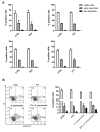Inhibition of Human Neutrophil Functions In Vitro by Multiple Sclerosis Disease-Modifying Therapies
- PMID: 33147889
- PMCID: PMC7692529
- DOI: 10.3390/jcm9113542
Inhibition of Human Neutrophil Functions In Vitro by Multiple Sclerosis Disease-Modifying Therapies
Abstract
There is a growing optimism about the potential of new disease-modifying therapies (DMTs) in the management of relapsing-remitting multiple sclerosis (RRMS) patients. However, this initial enthusiasm has been tempered by evidence indicating that multiple sclerosis (MS) patients undergoing DMT may be at higher risk of developing infections through incompletely understood mechanisms. As neutrophils provide the first line of defense against pathogens, here we have compared the effects of some of the commonly used MS DMTs (i.e., moderate-efficacy injective, first-line: interferonβ-1b (IFNβ-1b), glatiramer acetate (GA); and high-efficacy, second-line: fingolimod (FTY) and natalizumab (NAT)) on the in vitro viability and functions of neutrophils isolated from healthy subjects. All the DMTs tested impaired the ability of neutrophils to kill Klebsiella pneumoniae, whereas none of them affected the rate of neutrophil apoptosis or CD11b and CD62L cell surface expression. Intriguingly, only FTY exposure negatively affected K. pneumoniae-induced production of reactive oxygen species (ROS) in polymorphonuclear leukocytes (PMNs). Furthermore, neutrophils exposed to K. pneumoniae secreted enhanced amounts of CXCL8, IL-1β and TNF-α, which were differentially regulated following DMT pretreatment. Altogether, these findings suggest that DMTs may increase the susceptibility of MS patients to microbial infections, in part, through inhibition of neutrophil functions. In light of these data, we recommend that the design of personalized therapies for RRMS patients should take into account not just the mechanism of action of the chosen DMT but also the potential risk of infection associated with the administration of such therapeutic compounds to this highly vulnerable population.
Keywords: Klebsiella pneumoniae; disease-modifying therapies; multiple sclerosis; neutrophil functions.
Conflict of interest statement
The authors declare no conflict of interest.
Figures






Similar articles
-
Disease-Modifying Therapies for Relapsing-Remitting and Primary Progressive Multiple Sclerosis: A Cost-Utility Analysis.CNS Drugs. 2018 Dec;32(12):1145-1157. doi: 10.1007/s40263-018-0566-9. CNS Drugs. 2018. PMID: 30141001
-
The effectiveness of interferon beta versus glatiramer acetate and natalizumab versus fingolimod in a Polish real-world population.PLoS One. 2019 Oct 24;14(10):e0223863. doi: 10.1371/journal.pone.0223863. eCollection 2019. PLoS One. 2019. PMID: 31647829 Free PMC article.
-
Multiple sclerosis: current and emerging disease-modifying therapies and treatment strategies.Mayo Clin Proc. 2014 Feb;89(2):225-40. doi: 10.1016/j.mayocp.2013.11.002. Mayo Clin Proc. 2014. PMID: 24485135 Review.
-
Established disease-modifying treatments in relapsing-remitting multiple sclerosis.Curr Opin Neurol. 2015 Jun;28(3):220-9. doi: 10.1097/WCO.0000000000000202. Curr Opin Neurol. 2015. PMID: 25923124 Review.
-
Comparative Effectiveness of Rituximab and Other Initial Treatment Choices for Multiple Sclerosis.JAMA Neurol. 2018 Mar 1;75(3):320-327. doi: 10.1001/jamaneurol.2017.4011. JAMA Neurol. 2018. PMID: 29309484 Free PMC article.
Cited by
-
The Role of Neutrophils in Multiple Sclerosis and Ischemic Stroke.Brain Sci. 2024 Apr 25;14(5):423. doi: 10.3390/brainsci14050423. Brain Sci. 2024. PMID: 38790402 Free PMC article. Review.
-
Dalbavancin Boosts the Ability of Neutrophils to Fight Methicillin-Resistant Staphylococcus aureus.Int J Mol Sci. 2023 Jan 28;24(3):2541. doi: 10.3390/ijms24032541. Int J Mol Sci. 2023. PMID: 36768864 Free PMC article.
-
Associations of myeloid cells with cellular and humoral responses following vaccinations in patients with neuroimmunological diseases.Nat Commun. 2023 Nov 25;14(1):7728. doi: 10.1038/s41467-023-43553-z. Nat Commun. 2023. PMID: 38007484 Free PMC article.
-
[Design and inflammation-targeting efficiency assessment of an engineered liposome-based nanomedicine delivery system targeting E-selectin].Nan Fang Yi Ke Da Xue Xue Bao. 2025 May 20;45(5):1013-1022. doi: 10.12122/j.issn.1673-4254.2025.05.14. Nan Fang Yi Ke Da Xue Xue Bao. 2025. PMID: 40415433 Free PMC article. Chinese.
References
-
- Luna G., Alping P., Burman J., Fink K., Fogdell-Hahn A., Gunnarsson M., Hillert J., Langer-Gould A., Lycke J., Nilsson P., et al. Infection Risks Among Patients with Multiple Sclerosis Treated With Fingolimod, Natalizumab, Rituximab, and Injectable Therapies. JAMA Neurol. 2020;77:184–191. doi: 10.1001/jamaneurol.2019.3365. - DOI - PMC - PubMed
Grants and funding
LinkOut - more resources
Full Text Sources
Research Materials

